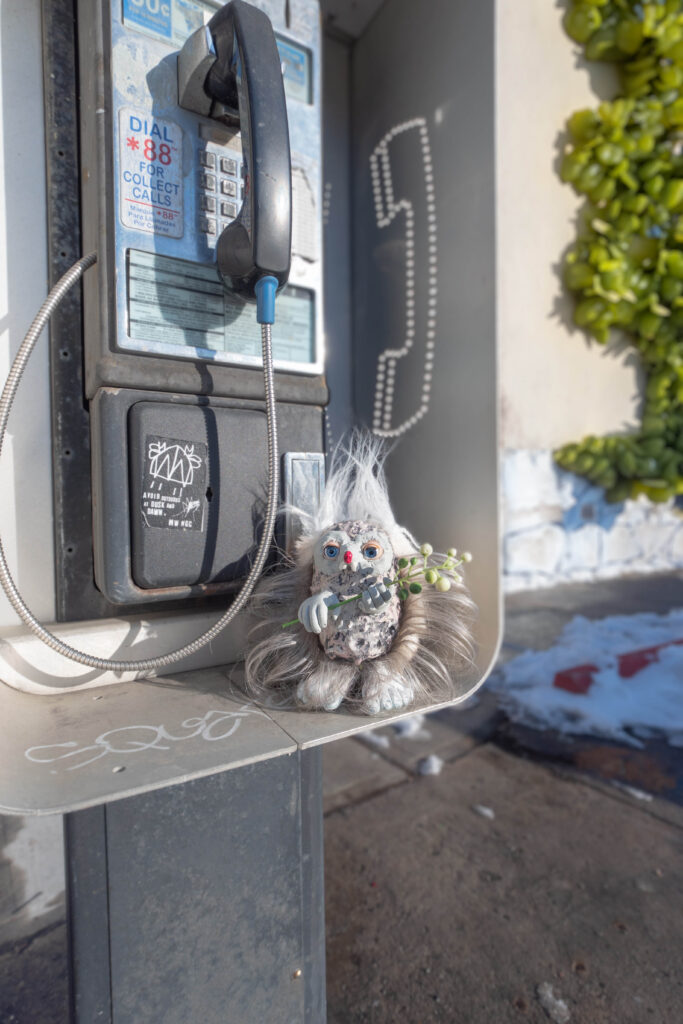Your cart is currently empty!
INTERVIEW | Beki Song
Beki Song is a Korean artist based in New York, NY. She graduated from the School of the Art Institute of Chicago in 2021 with a Bachelor of Fine Arts and a Master’s degree at Parsons, the New School for Design in 2024. In 2022, Song had her debut solo show in Seoul and has participated in group exhibitions since 2020. Song’s work explores the themes of infinite and unconditional love, as well as its opposites—darkness, lack, and distortion. She sculpts life-like beings using materials such as clay, plaster, and synthetic hair, creating spaces for them to inhabit. While acknowledging that these creatures may evoke discomfort, she embraces every aspect of them, using her work to explore the relationship between creator and created.
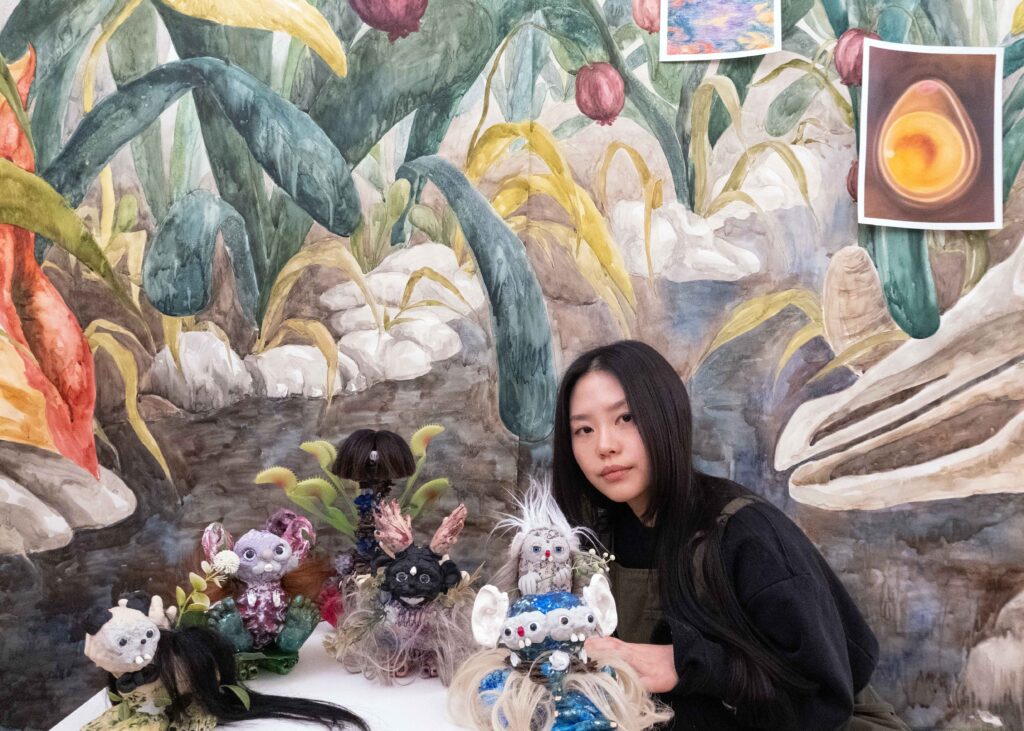
Personal Website : https://bekisong.cargo.site/ | Instagram : https://www.instagram.com/bbekisong/
I am a small god of this world. (This is not blasphemy.)
My work explores the concept of love, but love is never simple. I am drawn to infinite and unconditional love, yet from its deepest abyss emerge its opposites—absence, distortion, and darkness.
Like the story of The Prodigal Son, I investigate the paradox of unconditional love. Why does a protector love their child as they are? Why do we embrace imperfection? My work delves into the relationship between creator and creation, protector and beloved, questioning the very nature of love.
Through this exploration, I create sculptures I call wild babies. They are distorted yet full of life. They have eyes and mouths, but they may evoke discomfort in the viewer. My wild babies embody my raw emotions, untamed curiosity, and uncontrollable inner self. I sculpt them using materials such as clay, plaster, synthetic wigs, and artificial plants, infusing them with personality and presence.
The creation of these beings is inspired by the story Where the Wild Things Are. In the book, Max’s wild things represent his unruly, uncontrollable inner nature, but in the end, he leaves them behind to return to the love of his mother. My wild babies, however, continue to ask questions: Does perfect love exist? In what forms does love manifest?
I also create the worlds in which they dwell. Through sculpted environments and paintings, I construct spaces where they can fully exist. The world may see them as strange or unfamiliar, but I cherish every part of them. Love is not always beautiful or comforting—it can be imperfect, chaotic, and even unsettling. My sculptures give physical form to these questions.
In this way, I create my own universe.
And within it, I exist as a small god.
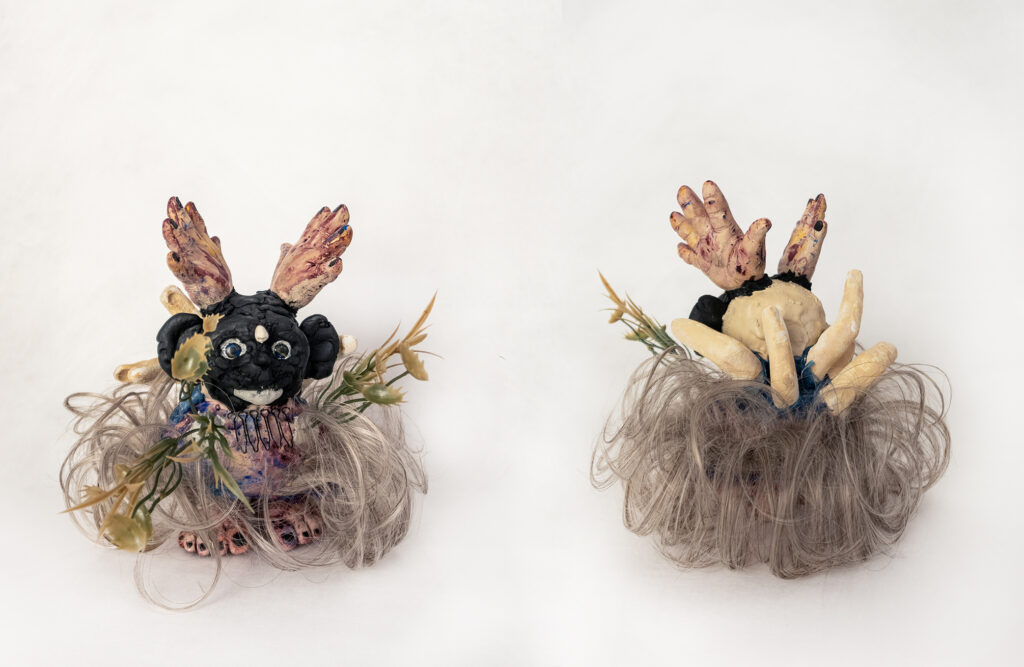
Right: Swamie – Back (2024) 8 x 8 x 7” Epoxy clay, plaster, fake plant, synthetic hair, acrylic paint, wax, marble, molded fingers
1.Can you share what initially drew you to sculpture and installation as your primary medium?
I originally majored in painting and stuck with it for a long time. However, I started feeling that there were limitations in expressing what I wanted on a flat 2D surface. The shift to sculpture and installation happened after I encountered the work of an artist named David Altmejd. Seeing his work inspired me to try sculpture. I’ve always liked toys and stuffed animals, so I decided to explore that direction. Through this, I discovered how fun it is to create sculptures and installations, and now I can’t seem to get out of it. It feels like creating a small world that offers a sense of comfort. Recently, Camille Henrot’s works in immersive spaces have given me even more inspiration and passion for sculpture and installation. But I still love painting too!
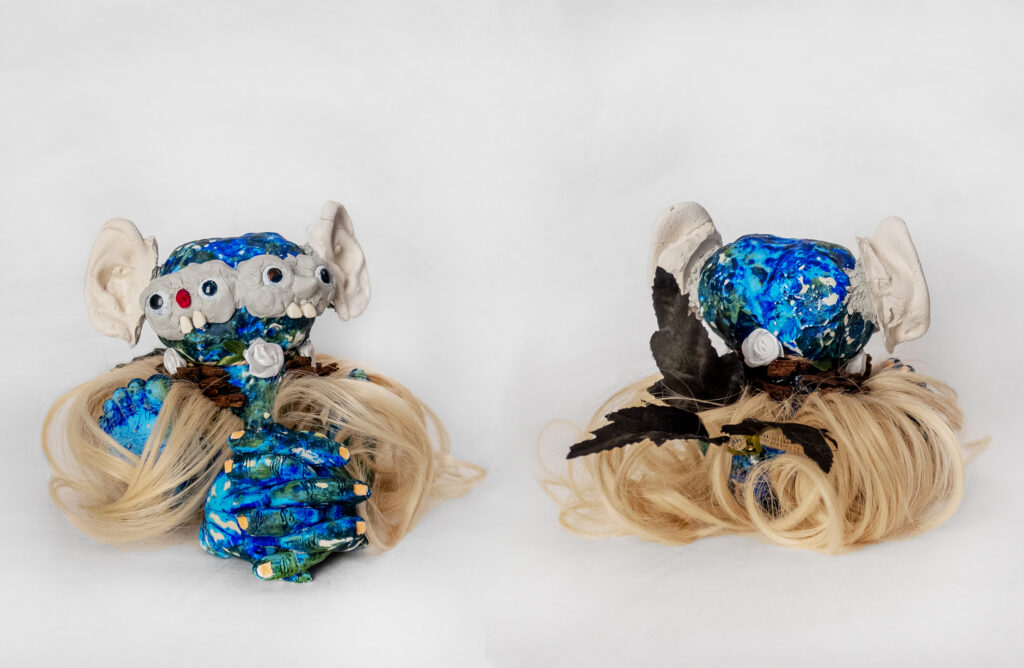
Right:Siameseee – Back (2024) 10 x 7.5 x 5.5” Epoxy clay, plaster, fake plant, synthetic hair, acrylic paint, marble, resin, wood skin
2.Your work explores deep emotional themes. Was there a specific moment or experience that led you to this focus?
I believe everything in life, as a human, starts from relationships. Personally, I think love is the most important emotion in human relationships—especially complex love. From the moment we are born, love is the first emotion we receive, and it profoundly impacts our emotional development as babies and continues to influence us into adulthood.
Building relationships, loving, understanding, and empathizing with each other—that’s what shapes our entire lives. I didn’t think much about this before, but as I live my life, I reflect on my actions and words and think about what love means. I also consider how my early relationship with my parents affects who I am today. I grew up in a Christian household and was taught that among faith, hope, and love, the most important is ‘love,’ and I’ve always wondered why it holds such significance
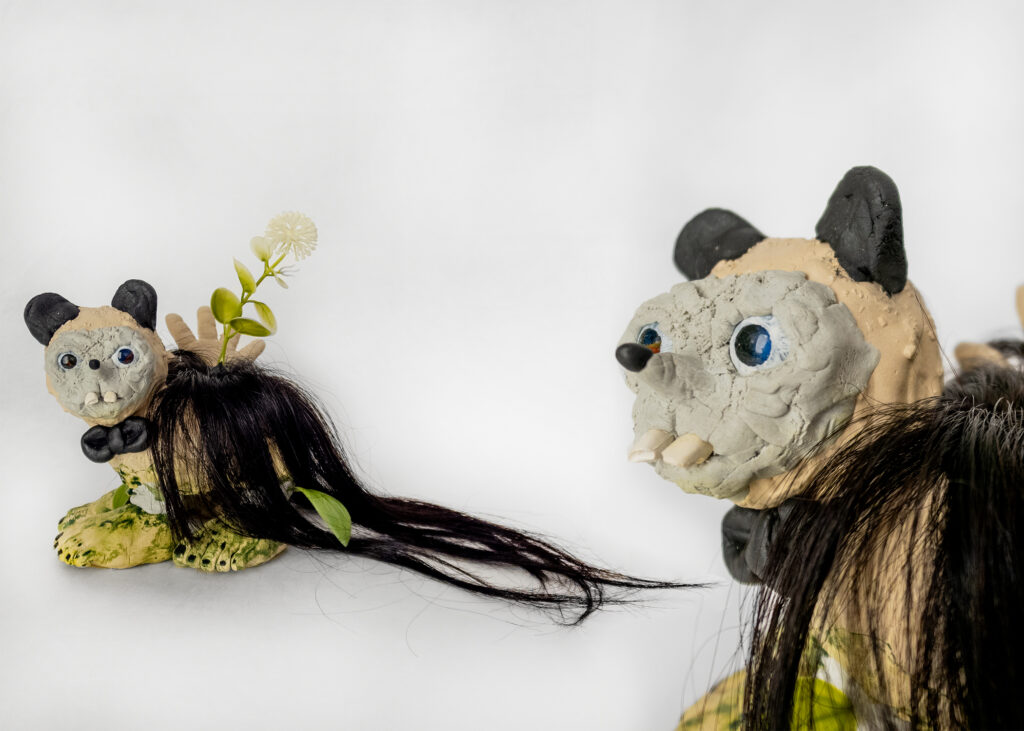
Right: Sprout and Fortitude (2024) 8x 8 x 7.5” Epoxy clay, plaster, syntheetic hair, fake plant, marble, acrylic paints
3.You describe your work as an exploration of infinite and unconditional love, yet also its opposites—darkness, absence, and distortion. How do you balance these contrasts in your creative process?
This is such an interesting question! I haven’t really thought about how I balance love and its opposites like darkness and distortion. I think they naturally come with each other. Love is a complex emotion. Perfect love doesn’t seem to exist, and I’m not sure if there’s a balance in love either. Human emotions are fascinating because they can shift quickly, and we can feel many emotions all at once. I don’t consciously balance the contrasts. It’s more spontaneous—created in the moment. I create imperfect beings; they are both cute and a bit grotesque, like twisted little monsters, yet I love them.
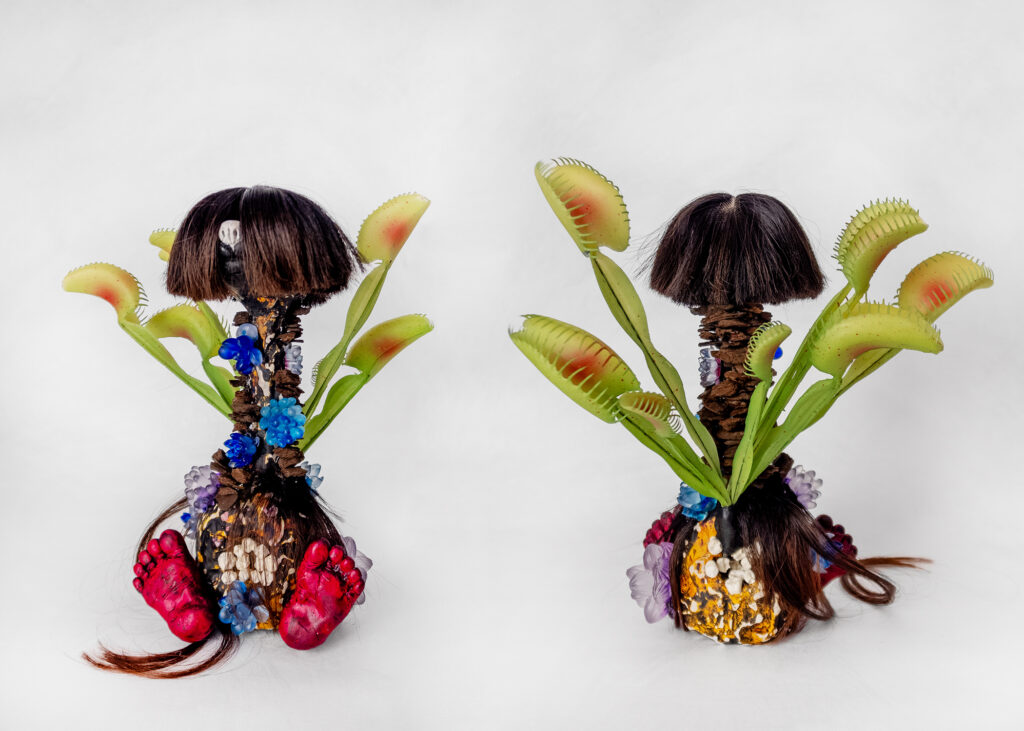
Right: Gloster tesem- Back (2024) 8.5 x 10.5 x 8” Epoxy clay, pllaster, fake plant, synthetic hair, acrylic paint, marble, resin, wood skin
4.You reference The Prodigal Son and Where the Wild Things Are in your artist statement. How do these narratives shape your understanding of love and creation?
I grew up in a Christian household, so I have drawn a lot of inspiration from biblical stories. When I first heard the story of the Prodigal Son, I, being someone who hasn’t become a parent yet, saw it from the son’s perspective. From a child’s perspective, the Prodigal Son seems ungrateful, which I can relate to. However, I couldn’t empathize with the father who endlessly waits and welcomes his son with open arms despite the son’s mistakes. This story is a metaphor for the relationship between God and humans. Furthermore, God shows His love for humanity by sacrificing His son, Jesus. As a child and as a human, I couldn’t fully understand that. This curiosity led me to my current work.
Similarly, in Where the Wild Things Are, Max’s adventures with the wild things represent a child’s inner wildness. His mother, who loves him unconditionally, is always waiting for him,eventhough she wans’t happy with Max’s wildness. Max was called a ‘wild thing!’ and sent to bed without supper. Though he had fun with the wild creatures, he eventually felt lonely and longed for love. So he gave up his throne and returned home, where his supper—and his mother’s love—was waiting for him.
I create monsters from the perspective of Max, a child, a human, and the Prodigal Son. The monsters are both my mischievous curiosity and my wayward inner self, while at the same time, I try to take on the role of a creator, embodying the parent and god who both create and love imperfect beings by making them and bringing them to life.
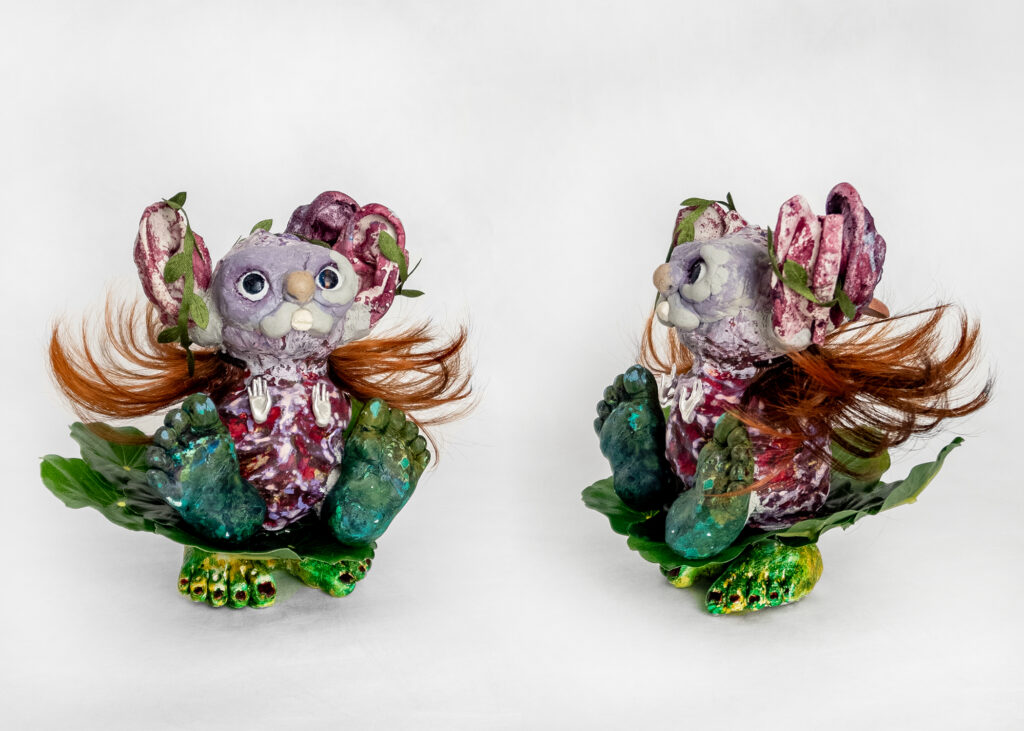
Right: Lotuie – side (2024) 8.5 x 8.5 x 7.5” Epoxy clay, plaster, fake plant, synthetic hair, acrylic paint, marble, resin, earing, fake mushroom
5.Do you see your sculptures as self-portraits in a way? How much of yourself do you see in your wild babies?
I feel like I view the monsters in a similar way to Max in Where the Wild Things Are. The monsters are the wildness inside Max, and he is the king controlling them. Just like how Max sails off to meet the monsters and goes to their land, I also view my sculptures as part of my inner self, but at the same time, I see them as slightly separate from me. They exist within me, but I also see them as living beings with their own identities, or sometimes as my children.
For example Swamiee is based on the concept of a being that lived inside my stomach. I was inspired from a photo of a tumor with hair and teeth. Swamiee is a friend who came out by opening my belly button. It lives in a swamp, a damp and humid place like the intestines. But Swamiee feels loneliness and tries to find a being like itself. So, it sometimes opens the belly buttons of humans or animals that have accidentally drowned in the swamp. Swamiee is a creature that came out of my intestines, and it represents my loneliness.
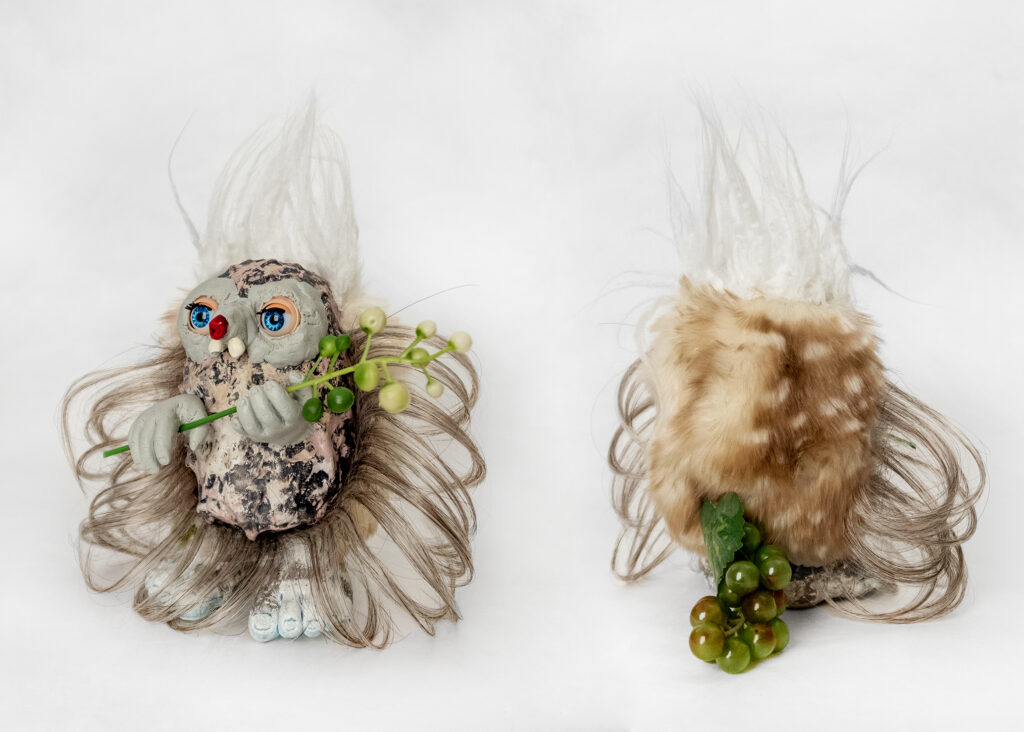
Right: Dionies- Back (2024) 7 x 8 x 7” Epoxy clay, plaster, fake plant, synthetic hair, acrylic paint, toy eyes, faux fur
6. Your use of materials like synthetic hair, artificial plants, and plaster gives your sculptures a lifelike presence. What draws you to these materials, and how do they contribute to the themes of your work?
Certainly, attaching human-like hair gives a sense of similarity, but it’s not quite human. It creates both a sense of connection and, at the same time, discomfort. I find it an interesting material that evokes both feelings. It seems to elevate the vitality of the work. As for plaster, I am drawn to the fact that I can’t fully control it. I want my sculptures to be born with their own unique freedom. With clay or modeling materials, I tend to end up controlling them too much. Artificial plants are interesting because they can create their own stories, so I use them often, and recently, I’ve also been experimenting with natural materials like pebbles and shells.
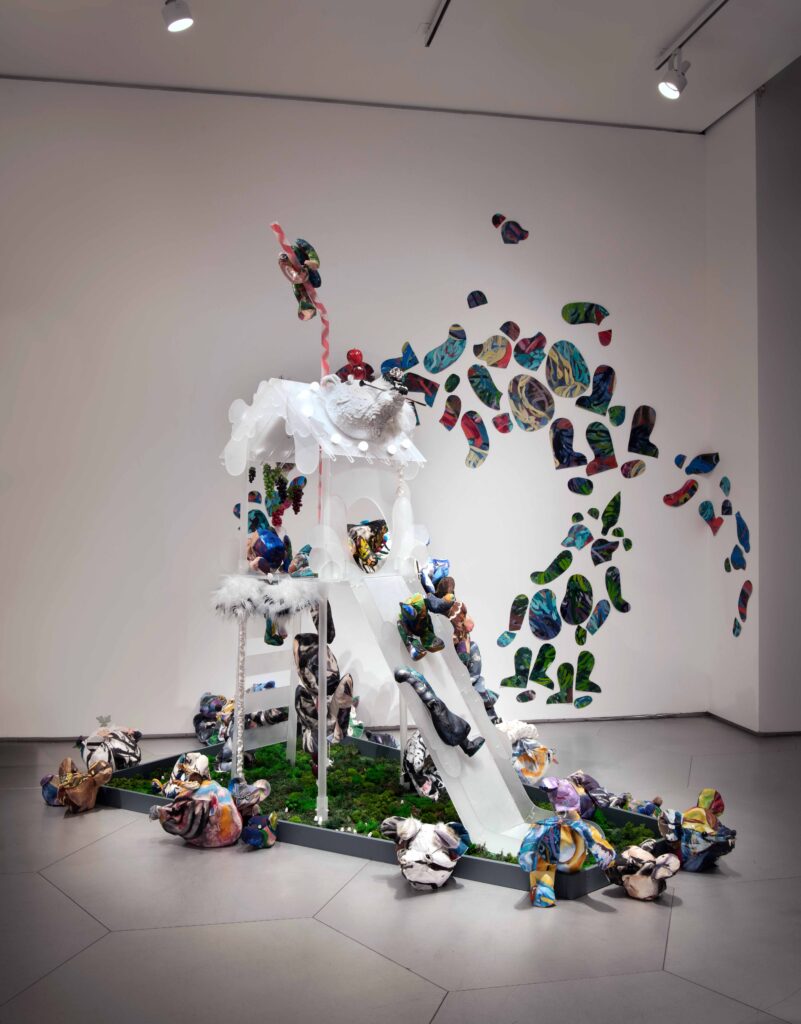
7.You don’t just create sculptures; you create environments for them to inhabit. How do you envision these spaces? Do they reflect real-world influences or purely imagined worlds?
Imagination is important, but when actually conceptualizing my works, I find myself drawing a lot of inspiration from reality. Since my sculptures are small, the way they are viewed gives the impression of tiny beings living in the world. Like the animation Antz, Bug’s Life, and Troll have influenced me, and I try to imagine the space in which they would live not far from human’s world. I also take inspiration from documentaries and nature photography to solidify their world. Meaning is also crucial, so the space where they live is Tulip Land. The meaning of the tulip flower is ‘eternal love’.
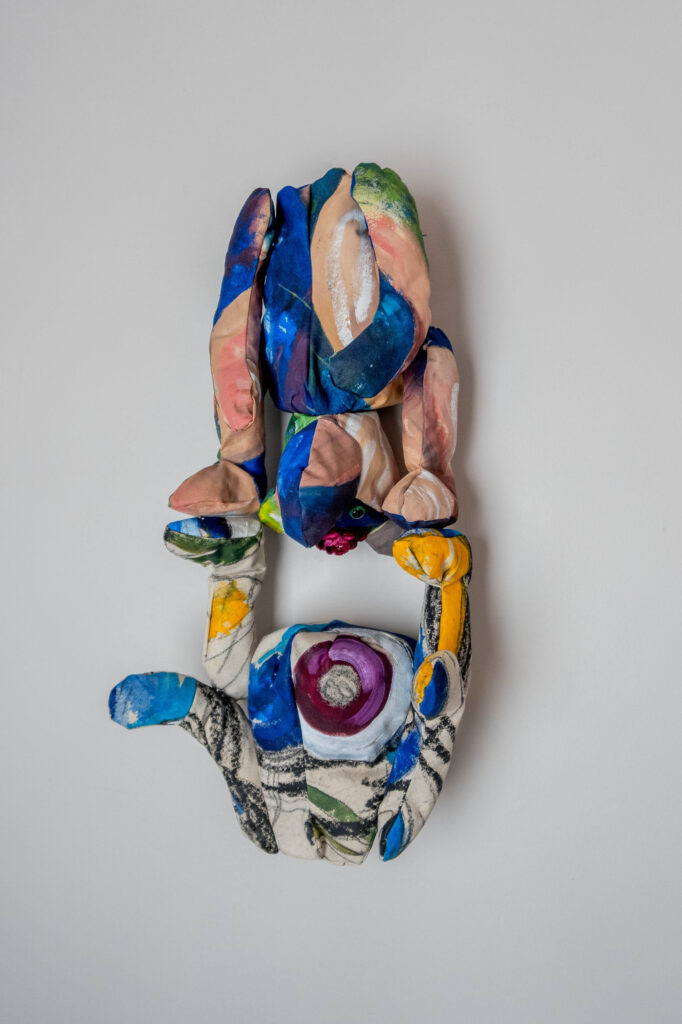
8.If your universe had its own mythology, what would its core belief or philosophy be?
I still feel like there are aspects that need more thought and development, but for now, I see it as an exploration of ‘the incomprehensible nature of love.’
When I think about why parents love their children unconditionally, I wonder if it’s because the child is something they’ve created. Even if they didn’t give birth to them directly, they say they ‘gave birth’ with their hearts. Does God love humans because He created them? That’s something I think about too.
But just like humans are imperfect, love can’t be perfect either. And within the concept of love, various wounds inevitably arise—like obsession, for instance. One might become obsessed because of love, but from the other person’s point of view, it could feel like pain.
There’s also the story of King David and Bathsheba in the Bible. God loved David so much, but because of his wrong choices, his descendants were cursed, even though David repented.
In my worldview, my mythology explores both the positive and negative aspects of love together—the incomprehensible nature of love. Each of my sculptures tells its own story about love. I’m in the process of writing the stories of exploration for each piece.
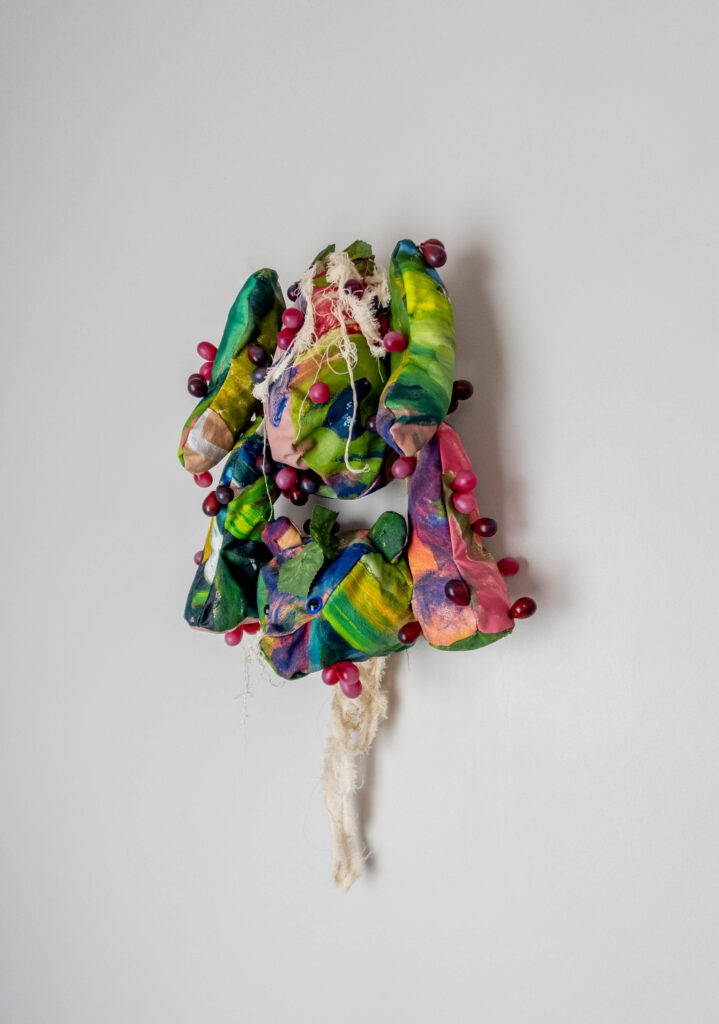
9.You describe yourself as a “small god” in your artistic universe. How does this perspective influence your relationship with your creations?
As I’ve mentioned before, my sculptures are my inner monsters, yet they also have their own separate identities. By bringing them into existence, I view them both as part of me and as independent beings with their own essence. Also, to explore the role of a parent who loves imperfect, mischievous children. I try to see myself as a creator who embodies the perspective of a god who has created life. It might be hard to understand—it’s me, but at the same time, I am the creator. However, it becomes a little easier to grasp if we look at it this way: In Genesis, there is a part that says God created humans in His own image.
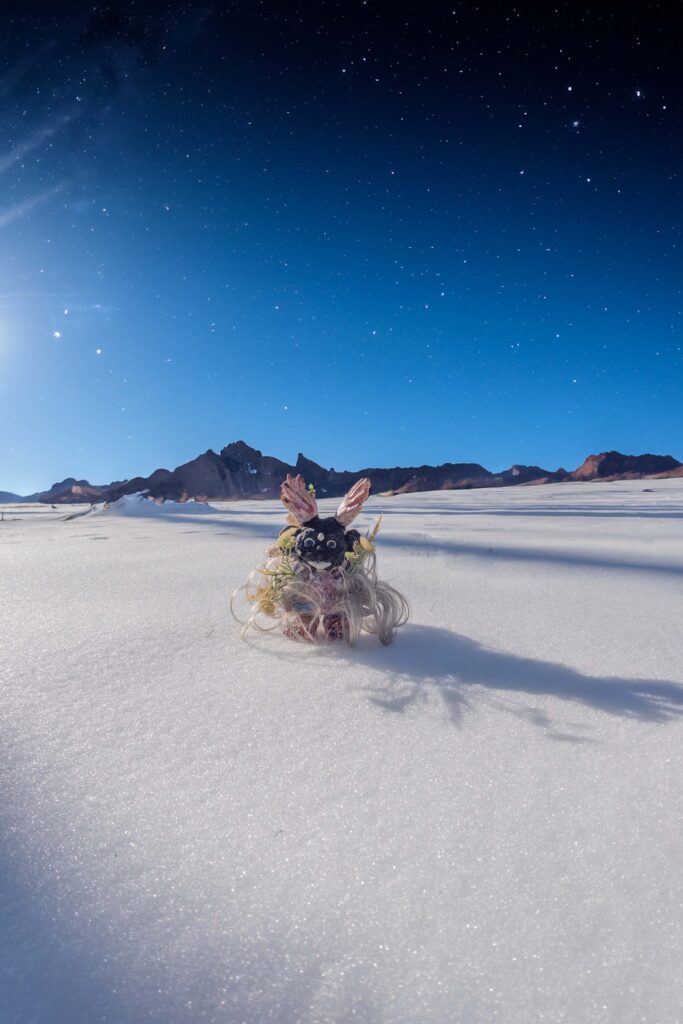

10.Has your understanding of love and its complexities evolved through making these works?
I’m still in the process of understanding love. I don’t know if I’ll ever fully grasp its complexities and depth, but the exploration continues!
